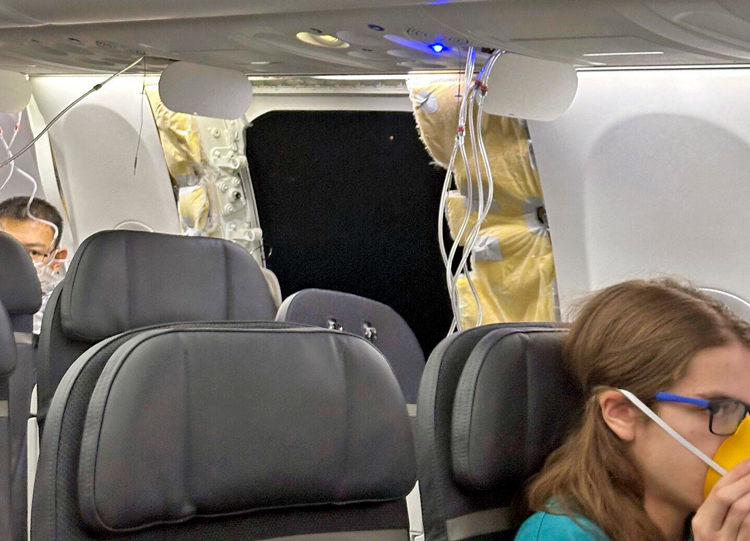The near disaster when a door-sized panel on an Alaska Airlines Boeing 737 Max 9 jet ripped off in midflight Jan. 5 exposes once again how the bosses’ drive for profits above all else comes at the expense of safety and workers’ lives. And it shows the complicity of U.S. federal agencies that are supposed to “regulate” the airworthiness of the nation’s aircraft.
With the door plug gone, air rushed out of the gaping hole in the plane, depressurizing the cabin at an altitude of 16,000 feet. The 171 passengers and six crew members were exposed to powerful winds. Because of the efforts of the pilots and flight attendants, the plane landed successfully in Portland, Oregon, with no further damage or threat to the passengers. Luckily, no one had been in the seat next to the panel when it blew out.
The following day the U.S. Federal Aviation Administration grounded 171 Max 9 jets for inspection. This includes nearly 20% of the planes flown by Alaska Airlines and 79 planes operated by United Airlines. Other carriers grounding Max 9s include Panama’s Copa Airlines, Aeromexico and Turkish Airlines.
These initial inspections have already exposed growing numbers of problems. Technicians at both Alaska and United found loose bolts and other defective parts on some planes as they accessed the door plug area to prepare the fleet for inspections. In the case of the Alaska Airlines Flight 1282 plane, it is unclear whether the four door plug bolts had ever been installed.
The FAA is supposed to inspect planes and certify that they can fly safely. But in many cases it delegates these responsibilities to third-party outfits or to the company that built the plane itself. The plane in the Alaska Airlines incident was granted an FAA airworthiness certificate Oct. 25, 2023, and was issued a seven-year certificate Nov. 2. However, the agency’s records do not say who granted the certificate.
The plane’s maiden flight took place in early November and safety issues arose right away. A warning light indicating pressurization problems on the plane went off three times, once in December and twice in the week leading up to the door plug tearing off. Alaska bosses responded by putting restrictions on the plane — it could continue flying, but not long distances over water!
This is far from the first potentially deadly malfunction that turned up on Boeing Max planes. Boeing 737 Max 8 aircraft went down in two deadly crashes that took 346 lives in 2018 and 2019. One crashed in Indonesia in October 2018, killing everyone on board. Six months later another crashed after takeoff in Ethiopia, again killing everyone on board.
Both disasters were caused by a new “anti-stall” software system, which became active without the crews’ knowledge and without having received training on it. This repeatedly forced the planes into what became uncontrollable dives. Boeing’s Max 8 planes were grounded for nearly two years, before government regulators declared them safe to fly again.
“‘This Has Been Going on for Years.’ Inside Boeing’s Manufacturing Mess,” was the headline on a feature article in the Jan. 13 Wall Street Journal. In their drive to speed up production and boost profits, Boeing bosses increased subcontracting and outsourcing work on key airplane components. One of these subcontractors is Spirit AeroSystems based in Wichita, Kansas, which up to 2005 had been part of Boeing. It builds fuselages used in many Boeing jets, including the Alaska Flight 1282 plane.
“We have planes all over the world that have issues that nobody has found because of the pressure Spirit has put on employees to get the job done so fast,” Cornell Beard, president of the International Association of Machinists union at the Wichita factory, told the Journal. The Boeing bosses plan to ramp up production to 42 planes a month by February, from the 31 a month produced a year ago.
The company is “acknowledging our mistake,” David Calhoun, Boeing’s chief executive, told the media Jan. 9 after the Alaska plane debacle, without explaining what “mistake” he was referring to. Boeing officials haven’t elaborated on his remark.
To guarantee the safety and lives of passengers and airline workers alike, airline unions need to fight to win workers control of production. The profit-driven bosses and their oh-so-compliant government have proved themselves incapable of doing the job. Boeing and other airline factory workers on the ground and flight crews in the air need the power to say, “Stop! This plane isn’t flying until we say it’s safe.”


